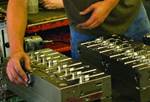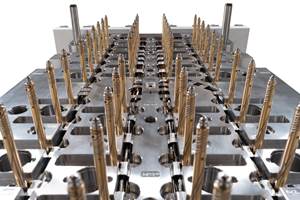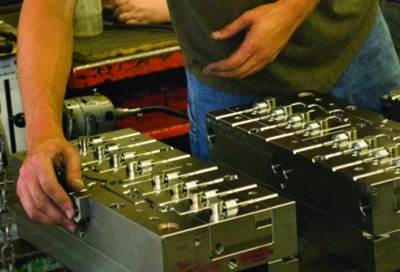Investing in Investment Casting
A look at mold design and building for investment casting.
Many mold manufacturers who wish to diversify may find that the investment in equipment and technology to do so a daunting prospect. Here’s a look at mold design and building for investment casting—a process that doesn’t involve using different equipment than what is used for traditional plastic injection mold building.
Class Tool and Die, Inc. (East Troy, WI) is a family-owned and run business that employs eight full-time and two part-time workers. In addition to offering plastic injection molds, rapid prototyping and machining services, the company also builds tools for investment casting in the automotive, fire arms, consumer products, defense and agricultural markets. According to Josh Rogosienski, Class Tool and Die’s Operations Manager, Southeastern Wisconsin is home to many investment casting foundries, which helped Class Tool decide to service that part of the industry and make it one of the company’s strengths.
“Building investment casting tools is very similar to building plastic injection molds,” explains Rogosienski. “The same equipment is used to produce both types of molds/tools, but most investment cast tools are machined in aluminum. In a sense, this makes them quicker to machine, but often they are more complex than injection molds.”
According to Rogosienski, most investment cast parts are solid bodies. “For example, a plastic box would be molded in two halves and assembled,” he explains. “This requires two plastic molds—with a traditional core side and cavity side for each half of the box. An investment cast box would be solid and require only one tool. If the box had a hole through it, you would use a slide to pull the core similar to a slide in a plastic mold. If the box had some interior wall reduction bigger than the hole, then a soluble tool would be used. A soluble tool basically forms the inside of the part. The cored hole and the wall reduction area would be formed in a second tool—filled with a soluble wax. The soluble wax pattern would then be laid in the pattern wrapper tool, and the pattern wax would be injected around the soluble wax. The assembled pattern is then soaked in a solution which dissolves the soluble wax—leaving the wax pattern intact. The interior shape can be very complex and still work with this procedure.”
Another difference between building plastic injection molds and building investment tools is gating. “To produce a casting, you need a place were the material is poured into—then cut off—the final part at the end; and most casting foundries like to inject into this gate,” Rogosienski elaborates. “This can affect the way the tool is built. Sometimes more upfront design time is needed to figure out how all of the undercuts and slide actions can pull to produce a part. Investment castings also tend to not have draft and often have sharp corners, which can require more EDM’ing.”
Rogosienski stresses that top-notch technology, equipment and employee training is paramount. “In order to provide the quality of service we are able to do to for investment casting companies, six of our employees were able to attend well-known technical schools in the area and are now state-indentured journeyman moldmakers,” he says. “But we don’t believe education stops after the classroom so we continually stay on the cutting-edge of the industry through the deployment of the most current programming and design software and machinery. Within the last year alone, we have added two new Mazak vertical CNCs to optimize production with ever-demanding deadlines.
“Although the technology makes it possible to increase profitability while maintaining efficiency, we have learned that in order to be successful in this competitive industry, adaptability to the customer’s needs is paramount,” he continues. “Without question, that need is shorter and shorter leadtimes.”
To market its investment casting services, Class Tool relies on word-of-mouth. “Another way we are able to indirectly promote ourselves is simply through prospects seeing and handling tools with our name engraved on it as they are passed from one foundry to another,” Rogosienski notes. “As with any tool or mold, building it is an art. It is hard to quantify the time and ingenuity that goes into creating a final piece, but we take pride in our products, and the engraving of our name is our way to prove that.”
If a mold manufacturer is willing to add investment casting services to its repertoire, Rogosienski recommends the old-fashioned, door-to-door salesman approach. “Visit some foundries/casters to show them some sample tools and see if they will give you a shot,” he says. “There are a lot less shops that cater to this service—but there are also a lot less foundries/casting houses compared to injection molders.
“References also work well,” he continues. “If your new prospect could call a molder you do work for now and hear that you are capable of producing quality molds on time, it might help ease the new customer’s mind. As with all tools built these days, it seems time and price are getting shorter and more cost-effective. This means you need to think outside the box.”
For More Information:
Class Tool and Die Inc. / (262) 642-2333
josh.r@classtd.com / www.classtd.com
Related Content
MMT Chats: The Connection Between Additive Manufacturing Education and ROI
This MMT Chat continues the conversation with Action Mold and Machining, as two members of the Additive Manufacturing team dig a little deeper into AM education, AM’s return on investment and the facility and equipment requirements to implement AM properly.
Read MoreHow to Solve Hot Runner Challenges When Molding with Bioresins
A review of the considerations and adaptations required to design hot runners and implement highly productive injection molding operations.
Read MoreThe Role of Social Media in Manufacturing
Charles Daniels CFO of Wepco Plastics shares insights on the role of social media in manufacturing, how to improve the “business” side of a small mold shop and continually developing culture.
Read MoreWhat is Scientific Maintenance? Part 2
Part two of this three-part series explains specific data that toolrooms must collect, analyze and use to truly advance to a scientific maintenance culture where you can measure real data and drive decisions.
Read MoreRead Next
New Business Opportunities: New Equipment Investment Solidifies Medical Mold Prototyping Niche
Investing in an additional high-speed machining center and converting to electric presses rather than hydraulic has allowed mold manufacturer/molder Injection Mold, Inc. (North Vernon, IN) to step up its game by speeding up already quick delivery times.
Read MoreReasons to Use Fiber Lasers for Mold Cleaning
Fiber lasers offer a simplicity, speed, control and portability, minimizing mold cleaning risks.
Read MoreHow to Use Strategic Planning Tools, Data to Manage the Human Side of Business
Q&A with Marion Wells, MMT EAB member and founder of Human Asset Management.
Read More






.jpg;maxWidth=300;quality=90)











